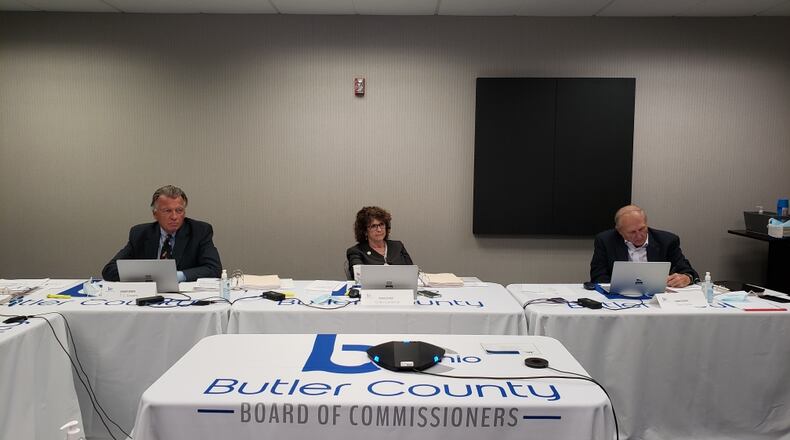The first round of funding arrived in May, the second half will arrive next spring and the commissioners have until 2024 to spend it. There are some restrictions on how the money can be spent, the main categories the Treasury identified as important are: public health, negative economic impacts, services to disproportionately impacted communities, premium pay for workers battling the pandemic, revenue replacement and improvements to water and sewer and broadband infrastructure.
The commissioners received an eclectic array of 33 funding requests including economic development projects, help for the homeless, propping up small businesses, park and bike trail expansion and a new county morgue to name a few. They range in price from $24 million for new advanced aviation and manufacturing training centers in Middletown and Hamilton to $125,000 for healthcare worker training.
To help the commissioners prioritize their preferences County Administrator Judi Boyko said staff is cataloging the projects “graphically and qualitatively by expenditure category as required by the American Rescue Plan Act, kind of a workable index so they can focus their priorities in a more efficient way.”
The commissioners have held several work sessions with 29 entities seeking cash but have not had a discussion amongst themselves on which projects they deem worthy. That conversation will likely happen after county budget hearings are over in November.
Things have gotten a little testy at times over the rescue funding and Commissioner Don Dixon said they are all keenly aware this is a huge responsibility.
“When you’re talking about $75 million bucks you get all kinds of pressure from different people and organizations who want a part of that,” Dixon said. “You know they can all come up with a good story and a good plan, but everybody’s got an idea and most of them don’t work. So you have to vet this stuff very carefully and look at what you can deliver and serve that can’t ever happen any other way.”
Commissioner Cindy Carpenter crisscrossed the county meeting with other governmental entities and other groups, compiling a plan that divided the funds between 21 projects. Her top priority is the $24 million Butler Tech request to build new job training centers in advanced aviation and manufacturing in the county’s to biggest cities.
Commissioner T.C. Rogers also told the Journal-News that one deserves serious consideration.
“It seems like the protocol for this is to almost partner with existing companies or firms that have a need, then you make the curriculum to fit that and the training,” Rogers said. “Then they have a job when they get out I think that’s important. If we can train them here, get them a job here, there’s a good chance they will stay here, that has always appealed to me.”
The commissioners didn’t say much during the presentations but there have been a couple hints at their thought process. When the county’s development director, David Fehr, was presenting a plan for $1.3 million to build a new taxiway and 10 hangars for corporate planes at the county-owned airport, Carpenter asked how this project would help the underprivileged population. He said it would create new jobs for people in that area. She still criticized the project.
“I do not think this in any way qualifies as lifting up those communities, communities of color, communities who have been struggling, I think it’s really unfair to say it’s in a qualified census tract so we need the money...,” Carpenter said adding the project should be funded by the county general fund not ARPA funds. “I’m sad to see what appears to be kind of a money grab.”
Likewise, when Serve City homeless shelter Executive Director David Hood asked for $5.1 million to help fund expanded programming and relocate the main shelter within Hamilton, Dixon said the plan appeared to him to be “mission impossible” because the shelter doesn’t have the assets to sustain such an expansion.
In Carpenter’s plan she allocated ARP dollars to 19 of the projects but did not give all of them the total amounts they are asking for. For example, the $11.5 million four tiny villages are seeking to make critical infrastructure repairs would only get $5 million in her plan.
That could be the case for the final awards as well, Commissioner T.C. Rogers said “it’s not the plan” to give everyone a little of the money “but I really don’t know if the ones that submitted proposals and are given awards will necessarily get their entire ask.”
Some of the requests don’t clearly fit into any of the Treasury guidelines, but Boyko said the revenue replacement category is kind of a broad catch-all they could employ.
“As we further evaluate these projects and measure them through multiple filters of American Rescue expenditure categories and guidance it is likely that some of them may result in not being eligible,” Boyko said but added if the board finds a particular project a priority they can fund it through the revenue replacement avenue.
While he wouldn’t cite any projects specifically, Dixon said some of the projects shouldn’t be approved on principle.
“Some of the projects and programs that some people want are fine if you’re using your own money, but it makes no sense to use taxpayers’ dollars,” Dixon said.
When asked if she thinks the board can come to consensus on which projects to fund Carpenter said “I think we have to.” She also has recommended funding some of the requests not through rescue funds but with left-over CARES money and or the general fund.
“I support granting the entire amount ($75 million) and then if a critical project comes to our attention, we could decide to fund it through the general fund,” Carpenter said. “I don’t think our arms are tied with regard to supporting projects.”
About the Author

